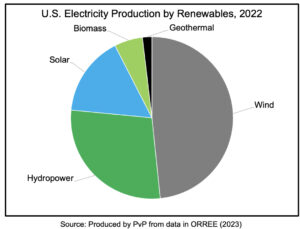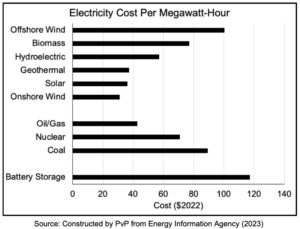Over the last 30 years, renewable energy systems such as solar panels and wind turbines have become major electricity sources for the United States. One mitigation strategy for climate change would involve vastly increasing renewable systems over the next two to three decades to the point that the United States could sharply reduce the amount of fossil fuels (coal, oil, and natural gas) used to produce electricity and for transportation. Reducing fossil fuel use is one of the ways that Americans could limit and reduce the amount of greenhouse gasses released into the environment.
This brief aims to lay out the feasibility of increasing our reliance on renewable energy and describe what such a transition would involve in terms of infrastructure changes, benefits and costs.
What are the principal renewable energy sources used in the United States?
Renewable energy is defined as energy that is produced from natural sources like wind, solar power, geothermal, biomass (plants), and hydropower. For the most part, renewable systems produce electricity; the exception is geothermal systems, which produce heat. Renewables are different from fossil fuels in two ways. One is that renewable energy is predominantly available from naturally replenished sources, compared to fossil fuels, which are limited to what is available under the Earth’s surface. The other advantage of renewable energy options is that they are typically cleaner, meaning subject to the mining of select minerals and the discarding of key components with limited life expectancy (i.e., batteries, solar panels, composite blades for turbines, etc.), their operation does not generate greenhouse gasses.
Not all clean energy sources are renewable. Nuclear fission systems, for example, are clean but not considered renewable because they rely on uranium mined from the ground.
How much renewable energy is currently produced in the United States?
As of 2022, roughly 20% of the total electricity produced in the United States is produced by renewable sources. About 20 percent is produced by nuclear fission sources, with the remaining 60% produced by fossil fuels. (For information on non-renewable sources, see our brief on decarbonization, which is linked in the Further Reading section.) The shares from different renewable sources are shown below.
Is the generation of renewable energy expected to increase?
The U.S. Energy Information Administration projects that renewable energy will account for a quarter of electricity production in 2024. The percentage is expected to further increase over time.
The increase in renewable use has two primary drivers, both related to the U.S. government subsidizing adoption. First, the cost of renewable energy systems has been steadily dropping as a result of available funding for research to improve renewable technologies. One study found that the cost of electricity generated by solar systems declined by 80 percent between 2011 and 2021. Second, the U.S. government has established substantial tax credits to offset the cost for individuals and businesses to install renewable systems.
Is renewable energy cost-competitive with fossil fuels?
Comparing the costs of renewable and fossil fuel systems is complicated. Estimates usually calculate the cost of building and operating different kinds of power plants, estimate how much energy each type of plant will produce, and calculate the cost per megawatt hour. (A megawatt-hour is the amount of electricity needed to run a typical US house for about a month.) The figure below shows the current cost estimates constructed by the U.S. Energy Information Agency for the various renewable and fossil fuel systems mentioned earlier.
For example, a new solar electricity system can generate electricity at about $35 per megawatt-hour. Onshore wind systems are even cheaper, at about $30 per megawatt-hour. Both of these costs are lower than those of nuclear fission systems (about $70 per megawatt-hour), coal-fired power plants ($42), or oil or natural gas plants ($90).
Data showing that some renewable systems are cost-competitive with fossil fuels and nuclear power leads many to advocate a country-wide transition to renewable energy production. Unfortunately, the decision is not that simple. As mentioned previously, a major consideration is that these estimates potentially require significant federal funding and related tax credits to reduce the cost of energy generated by renewable systems, both for utility providers and consumers of electricity. Without these subsidies, costs would rise substantially.
A mass transition would also raise two other problems. The first is that these cost estimates are for ideally-located systems. Solar systems do best in areas with clear skies and lots of sun, such as the Southwest United States, while wind systems do best in areas with strong average wind speeds, such as the Midwest and Texas. Geothermal systems are limited to areas with large temperature differences at different levels belowground. Hydropower requires deep, fast-running rivers. Thus, the actual cost of a country-wide transition would likely be much higher than these estimates because some systems will not work as well as others or because expensive transmission lines will be needed to move electricity from one part of the country to the other.
The second problem is that these cost estimates are for additions to the existing energy infrastructure, one where renewables play a significant but not dominant role. With current systems, if cloud cover remains over a solar panel array for a significant amount of time or the wind stops blowing at a wind turbine farm for an extended period, the amount of lost electricity is relatively small on a comparative scale to all sources of electric power generation today, and fossil fuel plants can increase their generation to compensate.
However, if renewables were the country’s main or only source of electricity, utilities would need to invest in many storage systems, such as batteries and other storage technology, to ensure they had enough stored energy to ride out any gaps in electricity production to avoid planned brownouts and uncontrolled blackouts. As the previous figure shows, the current cost of energy storage systems per megawatt-hour is very high. Utilities might need several megawatt-hours of storage for each megawatt-hour of renewable power. When these costs are added to renewable systems, they are not cost-competitive with fossil fuels. The 2022 Inflation Reduction Act is funding research on cheaper storage systems, but none are currently commercially available today.
Finally, each type of renewable system has unique disadvantages. Hydroelectric systems require building dams across rivers and releasing water in controlled amounts, harming fish and affecting recreational river use. Large solar systems take up considerable land, and in some cases due to construction have been recorded to leach unwanted chemicals back into the ground. Wind farms (particularly offshore) are sometimes opposed because they destroy scenic views and some speculate their construction and operation harm marine life. While there is no costless way to generate electricity, renewable systems in some ways concentrate these costs on a smaller portion of the population who live near these facilities which could be perceived as for the common good, whereas other non-renewable sources of electricity can potentially have a longer-term negative impact across a broader footprint, and again, rely on a limited supply of natural resources.
Even if it costs more, would a transition to renewables solve the problem of greenhouse gasses?
As discussed in our policy brief on Decarbonization, electricity generation is a large producer of greenhouse gasses but not the only producer. Even if the United States could switch entirely to renewable systems, it would still generate significant greenhouse gasses from air travel to cement production. As a matter of reference, for each new wind turbine it is estimated 600 cubic meters of concrete is needed for the base of each structure. A full transition to renewables would likely not move the United States to a “carbon neutral” state where the net amount of greenhouse gasses entering the atmosphere each year is zero. It will also be enormously expensive.
Also noted in the Decarbonization brief: the United States is a major producer of greenhouse gasses, but other countries, particularly China, India, and Russia, are also major producers. Less-developed African nations may also become major producers as they develop local industries and increase electrical production. Even if the majority of Americans thought the best path to Decarbonization was to transition to renewable energy systems, this move would have a minimal effect unless virtually all other developed and developing nations did so as well.
Further Reading
Office of Energy Efficiency and Renewable Energy (2023). Renewable Energy. United States Department of Energy. https://www.energy.gov/eere/renewable-energy, accessed 06/29/2023.
Colgan, J. D., and Hinthorn, M. (2023). International Energy Politics in an Age of Climate Change. Annual Review of Political Science, 26, 79-96.
Kebede, A. A., Kalogiannis, T., Van Mierlo, J., & Berecibar, M. (2022). A comprehensive review of stationary energy storage devices for large-scale renewable energy sources grid integration. Renewable and Sustainable Energy Reviews, 159, 112213.
Policy vs Politics Policy Brief: Decarbonization, available at https://policyvspolitics.org/decarbonization/
Sources
What are the principal renewable energy sources used in America?
Office of Energy Efficiency and Renewable Energy (2023). Renewable Energy. United States Department of Energy. https://www.energy.gov/eere/renewable-energy, accessed 06/29/2023.
Cole, W., Gates, N., & Mai, T. (2021). Exploring the cost implications of increased renewable energy for the US power system. The Electricity Journal, 34(5), 106957.
Vakulchuk, R., Overland, I., & Scholten, D. (2020). Renewable energy and geopolitics: A review. Renewable and Sustainable Energy Reviews, 122, 109547. https://doi.org/10.1016/j.rser.2019.109547.
Environmental Protection Agency. (2023). Overview of Greenhouse Gases. https://tinyurl.com/ms9fyk6v, accessed 06/29/2023.
Office of Nuclear Energy (2021). 3 Reasons Why Nuclear is Clean and Sustainable. United States Department of Energy. https://tinyurl.com/54trp5y8, accessed 06/29/2023.
How much renewable energy is currently produced in the United States?
Office of Energy Efficiency and Renewable Energy (2023). Renewable Energy. United States Department of Energy. https://www.energy.gov/eere/renewable-energy, accessed 06/29/2023.
Storrow, Benjamin (20222). U.S. Renewable Energy Will Surge Past Coal and Nuclear by Year’s End. Scientific American. https://tinyurl.com/truw5w4a, accessed 06/29/2023.
Is generation of renewable energy expected to increase?
Energy Information Administration. 2023. Short-term Energy Outlook. https://www.eia.gov/outlooks/steo/, accessed 06/29/2023.
IEA (2023). Innovation. https://www.iea.org/reports/clean-energy-technology-innovation, accessed 06/29/2023.
Are renewable systems cost-competitive with fossil fuels?
Energy Information Agency 2023. Levelized Costs of New Generation Resources in the Annual Energy Outlook, https://www.eia.gov/outlooks/aeo/electricity_generation/pdf/AEO2023_LCOE_report.pdf, accessed 3/1/24
Storrow, Benjamin (2022, November 22). U.S. Renewable Energy Will Surge Past Coal and Nuclear by Year’s End. Scientific American. https://tinyurl.com/truw5w4a, accessed 06/29/2023.
Environmental and Energy Study Institute. (2019). Fact Sheet | Fossil Fuel Subsidies: A Closer Look at Tax Breaks and Societal Costs (2019). https://tinyurl.com/ez8axws6, accessed 06/29/2023.
Berry, M. J., Laird, F. N., & Stefes, C. H. (2015). Driving energy: the enactment and ambitiousness of state renewable energy policy. Journal of Public Policy, 35(2), 297–328. http://www.jstor.org/stable/43864145.
Patonia, A., & Poudineh, R. (2023). Hydrogen storage for a net-zero carbon future. Oxford Institute for Energy Studies. http://www.jstor.org/stable/resrep48780
Kebede, A. A., Kalogiannis, T., Van Mierlo, J., & Berecibar, M. (2022). A comprehensive review of stationary energy storage devices for large-scale renewable energy sources grid integration. Renewable and Sustainable Energy Reviews, 159, 112213.
U.S. Energy Information Administration. (2022, December 30). Renewable energy explained: Incentives. https://tinyurl.com/4k9be6ee, accessed 06/29/2023.
Even if it cost more, would a transition to renewable systems solve the problem of greenhouse gasses?
Colgan, J. D., and Hinthorn, M. (2023). International Energy Politics in an Age of Climate Change. Annual Review of Political Science, 26, 79-96.
Contributors
Julia Acevedo (Intern) is a Political Science and Public Policy double major at Susquehanna University and is expected to graduate in May 2024 and pursue a Masters degree in Public Health.
Elijah Oaks (Intern) is a student at Dartmouth College. He is expected to graduate in May 2024 with a major in English and a minor in Religion. He is a Policy Fellow at The Cicero Institute.
Dr. Robert Holahan (Subject Matter Expert) is Associate Professor of Political Science and Faculty-in-Residence of the Dickinson Research Team (DiRT) at Binghamton University (SUNY). He holds a PhD in Political Science in 2013 from Indiana University-Bloomington, where his advisor was Elinor Ostrom.
Mary Adams (Team Lead) is a graduate student in the Department of Political Science at Indiana University and holds a Masters in Public Administration from Western Kentucky University. Her research is in American politics and political psychology.
Dr. Nathaniel Birkhead (Content Lead) received his PhD in Political Science from Indiana University. He is Associate Professor of Political Science and Department Chair at Kansas State University. His research focuses on American politics, especially Congress and state legislatures.
Dr. William Bianco (Research Director) received his PhD in Political Science from the University of Rochester. He is Professor of Political Science and Director of the Indiana Political Analytics Workshop at Indiana University. His current research is on representation, political identities, and the politics of scientific research.
Publication Log
Published – 4/23/24



